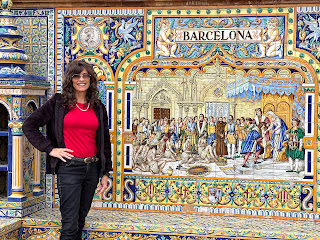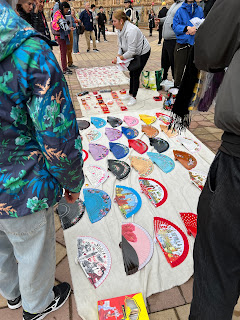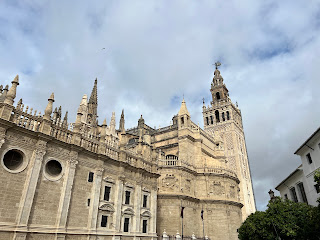Seville, Spain from Cadiz in Andalucia
Cruise day #12
The famous author, James Michener, describes Seville this way: Seville doesn’t have ambition, it IS ambition!
Today I visited Sevilla, Spain’s fourth largest city teaming with festivals, color, guitars, castanets, street life, and immersed in the fragrance of orange trees and jasmine. It claims the worlds largest Gothic cathedral, a spectacular royal palace and gardens ornamented with Islamic flair.
Here is Rick Steves description of Seville:
“Flamboyant Sevilla (seh-VEE-yah) thrums with famenco music, sizzles in the summer heat, and pulses with passion. It's a place where bullfighting is still politically correct and little girls still dream of being flamenco dancers.
While Granada has the great Alhambra and Córdoba has the remarkable Mezquita, Sevilla has soul.
As the capital of Andalucía, Sevilla offers a sampler of every Spanish icon, from sherry to matadors to Moorish heritage to fower-draped whitewashed lanes. It's a wonderful-to-be-alive-in kind of place.
As the gateway to the New World in the 1500s, Sevilla boomed when Spain did. The explorers Amerigo Vespucci and Ferdinand Magellan sailed from its great river harbor, discovering new trade routes and abundant sources of gold, silver, cocoa, and tobacco. For more than a century, it all flowed in through the port of Sevilla, bringing the city into a golden age. By the 1600s, Sevilla had become Spain's largest and wealthiest city, home to artists like Diego Velázquez and Bartolomé Murillo, who made it a cultural center.
But by the 1700s, Sevilla's golden age was ending, as trade routes shifted, the harbor silted up, and the Spanish empire crumbled.”
—————
My thoughts on my visit today:
Embarking from the vibrant port of Cadiz, our journey led us to Seville, the city pulsating with rich history and situated as the capital of the Andalusian region in Southern Spain.
Cadiz itself, prior to becoming Spanish, bore witness to the legacies of the Phoenicians, Greeks, Romans, and ultimately the Moors, each leaving an indelible mark. This cultural mosaic is evident in the stunning Moorish architecture, pedestrian-only streets, grand squares, fortress walls, diverse restaurants, and lively ambiance that grace the city.
The remnants of this Andalusian melting pot are omnipresent, manifesting in every corner. Exiting the grand cathedral, witness the original mosque walls adorned with Arabic inscriptions from the Koran. The iconic Giralda, symbolizing Seville, stands tall as a preserved minaret, a testament to the city’s layered history.
Our journey today touched upon Seville’s renowned landmarks—the Alcazar, Plaza de España, the cathedral (ranking as the third largest globally), and the old Jewish quarter. Each stop, albeit brief, offered a glimpse into the heart and soul of Seville, leaving an unforgettable impression. #SevilleGrabsYourHeart
PS once again, we just missed the rain.
































